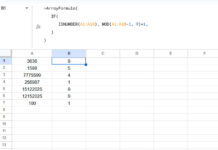You can use two XMATCH functions to count the number of cells between the first and last non-blank cells in a row in Google Sheets — both inclusive.
Formula to Count Cells Between First and Last Non-Blanks in a Row
=ArrayFormula(
IFNA(
XMATCH(TRUE, NOT(ISBLANK(row)), 0, -1) -
XMATCH(TRUE, NOT(ISBLANK(row)), 0, 1) + 1
)
)Here, row is the horizontal range (e.g., B2:H2) where you want to count the number of non-blank cells from the first to the last, including any blank cells between them.
Example
Assume you have an employee timesheet in the range A1:H, with working hours logged across weekdays:
| Employee | Mon | Tue | Wed | Thu | Fri | Sat | Sun |
|---|---|---|---|---|---|---|---|
| Emily | 8 | 8 | 7 | 4 | |||
| Michael | 8 | 8 | 8 | 8 | 8 |
You want to calculate the total span of days each employee was active, from their first entry to the last, including any off-days in between.
For Emily:
- First non-blank cell: Tuesday (
8) - Last non-blank cell: Sunday (
4) - Count of cells (Tue to Sun): 6 days
You can use the following formula in cell I2 and drag it down:
=ArrayFormula(
IFNA(
XMATCH(TRUE, NOT(ISBLANK(B2:H2)), 0, -1) -
XMATCH(TRUE, NOT(ISBLANK(B2:H2)), 0, 1) + 1
)
)
Formula Breakdown
1. NOT(ISBLANK(B2:H2)) – returns TRUE for each non-empty cell.
| FALSE | TRUE | TRUE | TRUE | FALSE | FALSE | TRUE |
2. Both XMATCH functions use this logical array to find positions:
3. The first XMATCH (search from end) returns the last non-blank cell.
4. The second XMATCH (search from start) returns the first non-blank cell.
Subtracting the two and adding 1 gives the total count between them, inclusive.
Count Cells Between First and Last Non-Blanks in a Row – Spill Formula
To apply this formula to multiple rows without dragging down manually, use the BYROW function:
=BYROW(B2:H, LAMBDA(row,
ARRAYFORMULA(
IFNA(
XMATCH(TRUE, NOT(ISBLANK(row)), 0, -1) -
XMATCH(TRUE, NOT(ISBLANK(row)), 0, 1) + 1
)
)
))Explanation:
LAMBDA(row, ...)defines a custom function for each row.BYROWapplies this function row by row over the range.- Inside the lambda, we’re just using the same formula from earlier.
Tip: Count Cells Between First and Last Non-Blanks in a Column
Want to do the same for vertical data? Just change the range to a column (e.g., B2:B20):
=ArrayFormula(
IFNA(
XMATCH(TRUE, NOT(ISBLANK(B2:B20)), 0, -1) -
XMATCH(TRUE, NOT(ISBLANK(B2:B20)), 0, 1) + 1
)
)To apply this across multiple columns, use the BYCOL function:
=BYCOL(B2:H10, LAMBDA(col,
ARRAYFORMULA(
IFNA(
XMATCH(TRUE, NOT(ISBLANK(col)), 0, -1) -
XMATCH(TRUE, NOT(ISBLANK(col)), 0, 1) + 1
)
)
))Note: You can rename the lambda variable to col for better readability in column operations.
Why Count Cells Between First and Last Non-Blanks in Google Sheets?
Use this technique to:
- Measure the active period in timesheets or logs.
- Analyze user engagement in row-wise data.
- Clean data with gaps while preserving the entry range.
- Automate row-wise or column-wise span calculations without scripting.



















